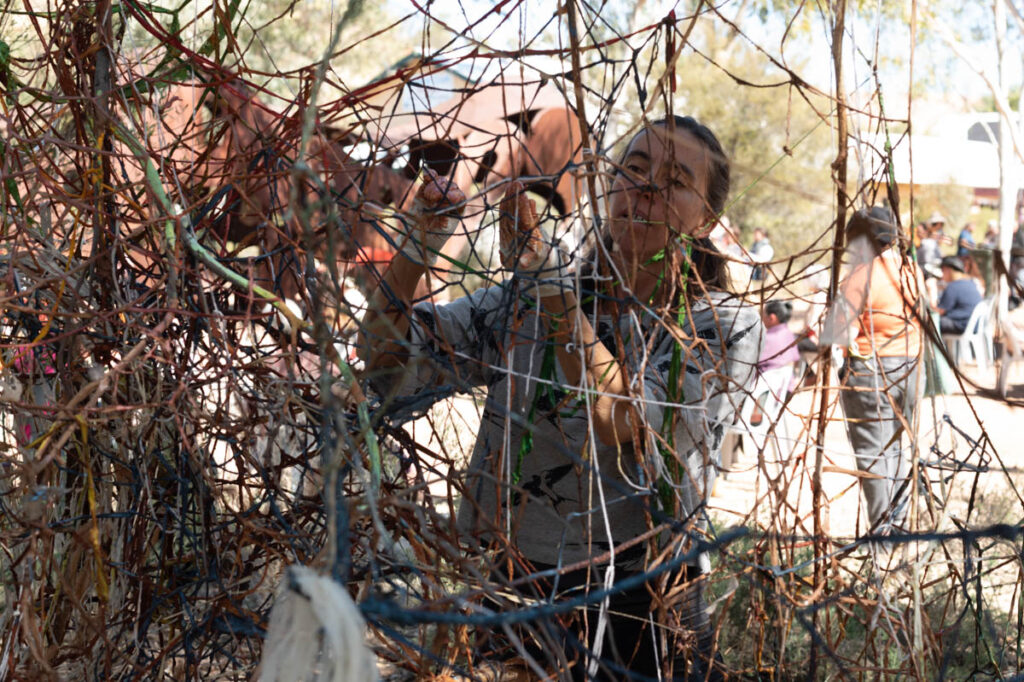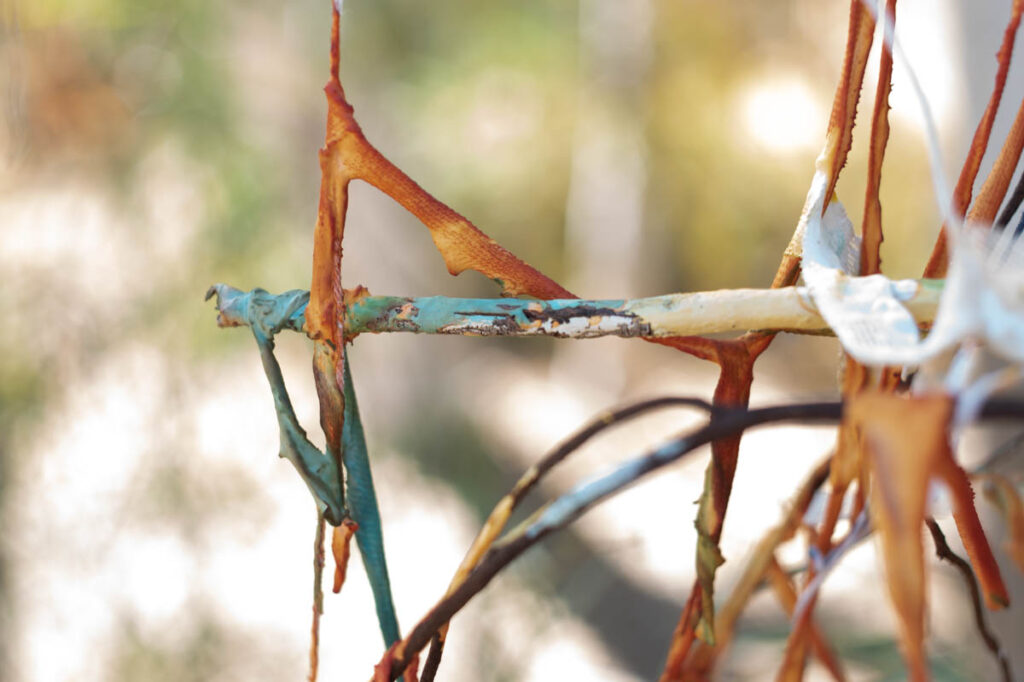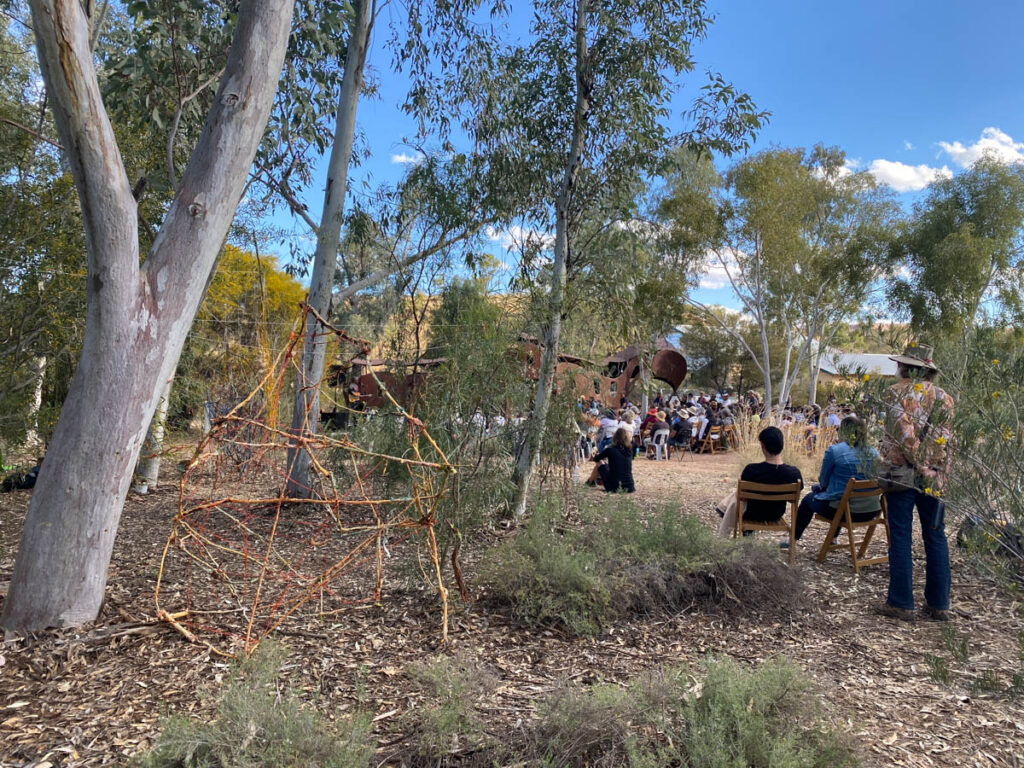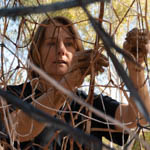
pattie beerens, place of not-knowing, 2022, clayweaving, collaborator tamara burlando, photo credit martina capurso.
pattie beerens enacts a unique ceramics practice that weaves with surrounding nature.
The pandemic saw my practice moving back home early in 2019. I felt constrained. No longer could I create large expansive messy works with colourful clay. I was back home where crafting is tidy, contained, and private. I was back in a safe space—alone with an aliveness of creations forming around me. It dawned on me that I had been creating safe spaces outside of home, in public places. With sloppy lines of fibre and clay, I had been weaving new places that were collaborative and shared. The weavings held traces and stories of forming. They created a dialogue with their surroundings.
Since this time, I have had the honour of exploring how we inhabit the world as part of sculpture, fibre, ceramics, and installation practice. I would like to share my recent experience in Mparntwe (Alice Springs) at the sixteenth Australian Ceramics Triennale. The video and the script were created as the weaving was forming over 15 days.
My interest is in the ethos that is emerging from my practice: caring for materials as kin—without hierarchy—crafting by “working with” more than “doing to” materials, and experiencing being part of, more than separate from, nature. The weavings that form are ephemeral. They fade, they soften, and they become skeletal. What remains are the stories. Stories like these.
Clay weaving
‘Werte’ – meaning hello in the language of the Arrernte (ar-en-da) people
My name is pattie beerens
I am the daughter of a Dutch migrant father and third-generation Australian mother of English, Scottish and Swedish descent.
I live on Wadawarrung Country along the Surf Coast of Victoria.
This is my story of a clay weaving collaboration created in Mparntwe (m-barn-twe)—Alice Springs—for the sixteenth Australian Ceramics Triennale.
It’s my story of being on this Country of the Arrernte people.
I learned how—before colonisation—visitors to Mparntwe would wait at the Gap in the MacDonnell Range—what the Arrente people, the traditional custodians of this Country, call Ntaripe (n-tare-pa)—visitors would wait until they were invited in.
It was sobering—and heartening—to hear a senior traditional custodian tell 400 or so visitors that she could therefore not welcome us.
We were already here—we have passed through Ntaripe

pattie beerens, place of not-knowing, 2022, clayweaving, collecting clay from the clay pans, photo credit bron field
place of not-knowing – on Arrernte Country.
We were weaving with clay and stories before the conference began.
With clay, the process forms as an exchange.
Clay takes moisture from our hands and forms from the pressure of our fingers.
Clay collects along cotton threads; it drips, it slumps, it glistens.
Clay is not object.
Clay is Country and place.
Clay weavings are traces of collaborations with the world around.
They form like drawings in space that can be woven and unwoven and added to endlessly.
The stickiness of the clay and the open weave of the process allow for ideas, thoughts and feelings to move through and between the fibres – to connect and become intertwined.
A tangle of stories woven together to say something of this world and show how it is possible to mend and grow.
Lines.
The lines pull us through space in ways obvious and unseen.
The lines contain, free, control, hold, break, embrace and connect.
The Latin word ‘linea’, from which the word ‘line’, originates means ‘linen thread or string’.
Consciously and unconsciously, we create places with lines.
Clay weaving is a process of making meandering lines – the wayfaring in our minds – visible.
Clay weaving is a language without words.
It bypasses the household of our minds by directly connecting one spirit to another.
It expresses the thoughts we don’t hear.
It wanders, it dances.
Listening.
For me, it’s about feeling and listening for things our ears cannot hear.
The weaving meandered over a few weeks into a response to feeling – more than seeing – an alchemy of colour and lines in the formations around me – from time, erosion, light and dark.
It has been teaching me how to acknowledge without knowing and to accept without understanding.
Someone here told me to listen to the trees to hear them drink.
I began hugging trees, with my ear to their trunk, but I cannot hear.
This continent is a storied place.
There’s so much memory, connection, story and song that’s held in every moment. Some I hear and some I don’t.
Clay.
I introduce myself to clay and clay introduces itself to me.
Acknowledging the provenance of clay – and collecting clay respectfully – is a ritual of clay weaving.
Extraction of clay for art can be an extraction of stories and spirithood.
I wonder as a white person – what does it mean to respect this Country.
Clay weaving is ephemeral.

pattie beerens, place of not-knowing, 2022, clay weaving, feelings of colour, photo credit martina capurso
The spirit of the earth is not torched with fire.
It is a challenging and often confronting exploration of inhabiting country.
Mparntwe.
This weaving records my story of visiting the clay pans with an Arrente man and his two children to collect a bucket of local clay.
The stories shared with me of his family and their unbroken connection with Country.
The connections we discovered by taking time—by sharing stories—how his father grew up in Essendon in Melbourne a few streets away from my mother.
The clay is smooth, sticky and deep brown.
It is unlike the gritty red clay from the cliffs on Wadawurrung Country where I live.
Landscape.
From early on this weaving was about landscape – it wouldn’t reveal itself from afar – It wanted to be discovered and appreciated from within – as fragments.
It invited us to wander in with our bodies and all of our senses – to become part of the work and part of its nature – not separate from it.
The work rested when it also became about respecting and not-knowing–not knowing this Country, not knowing its people and not knowing its ways—and being content at times with not knowing—not understanding.
Somethings are not for me to know or understand.
On the eve of the Triennale – the spirit and purpose of the weaving revealed itself.
It’s another story.
Tamara – a significant collaborator artist in this work – and I were creating a new form with sticks, clay and color.
Indigenous children began playing nearby.
Curious, they inched closer, and closer, until they couldn’t resist the sloppy, messy, colourful process of adding clay to the form.
Tamara greeted them– ‘mwarre’ (ma-re) – meaning good, well….
She chatted with the mother of the children – they were from Urapuntja (the Utopia Community).
It is a place that Tamara had worked, and they shared connections with the families they both knew.
The kids became engrossed in adding the final touches – they chose the colors and added wonderful swirls and marks to the form I was calling ‘rock’.
The older girl gave a name to ‘rock’.
I didn’t hear.
I asked her to repeat it.
I still didn’t hear.
Rock therefore has a name – I just don’t know what it is.
Humbled by their visit and the spirit of their contribution – these clay weavings began forming into place of not-knowing.

pattie beerens, place of not-knowing, 2022, clayweaving, The Australian Ceramics Triennale in the Araluen Cultural Precinct, photo supplied by artist
About pattie beerens
 To experience similar weaving stories please visit www.beerens.net.au and to follow weaving installations as they occur, please follow @pattiebeerens on Instagram. If you are nearby a weaving installation and would like to experience the process please connect with pattie beerens through either the website or Instagram. Photo of artist by Martina Capurso.
To experience similar weaving stories please visit www.beerens.net.au and to follow weaving installations as they occur, please follow @pattiebeerens on Instagram. If you are nearby a weaving installation and would like to experience the process please connect with pattie beerens through either the website or Instagram. Photo of artist by Martina Capurso.

